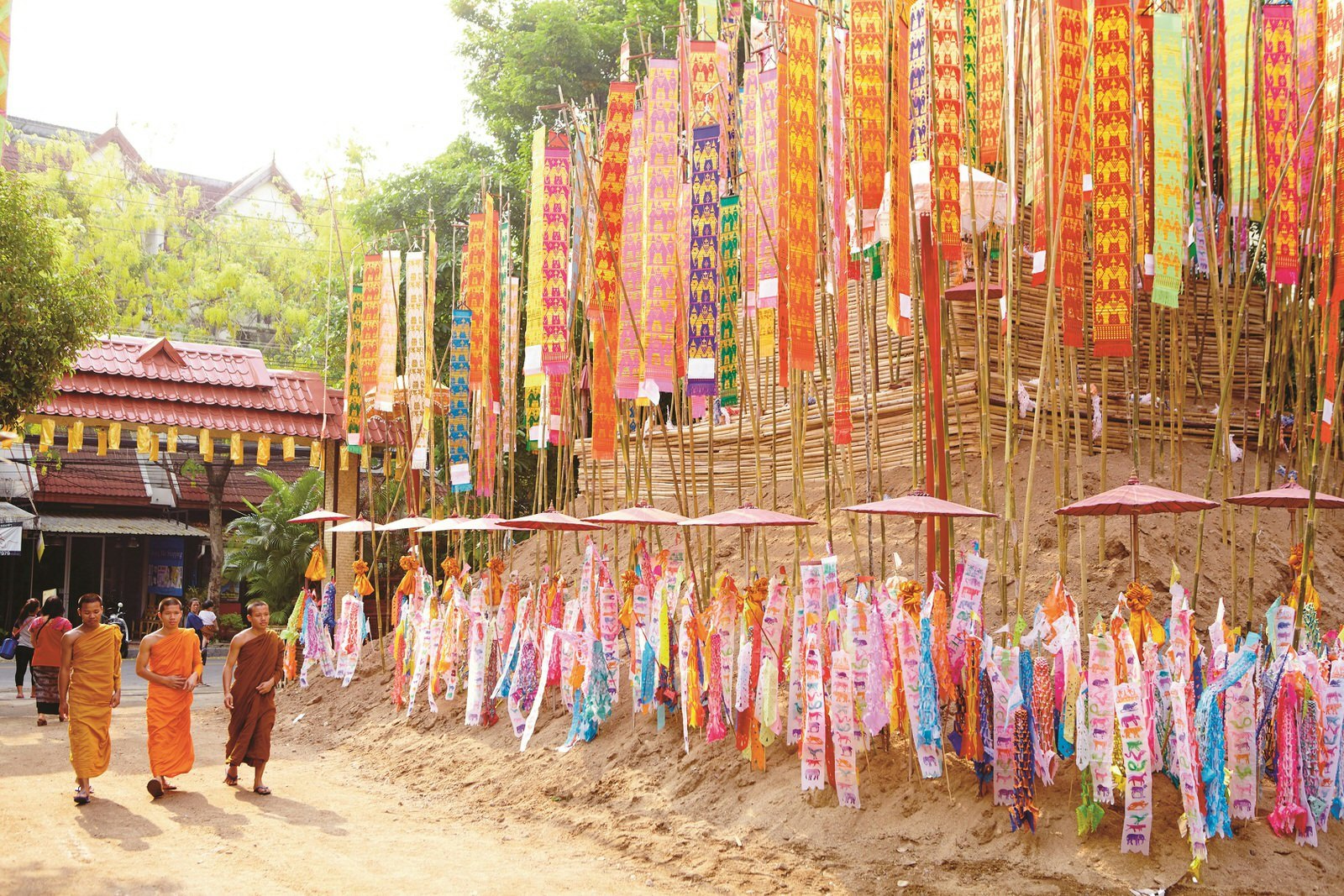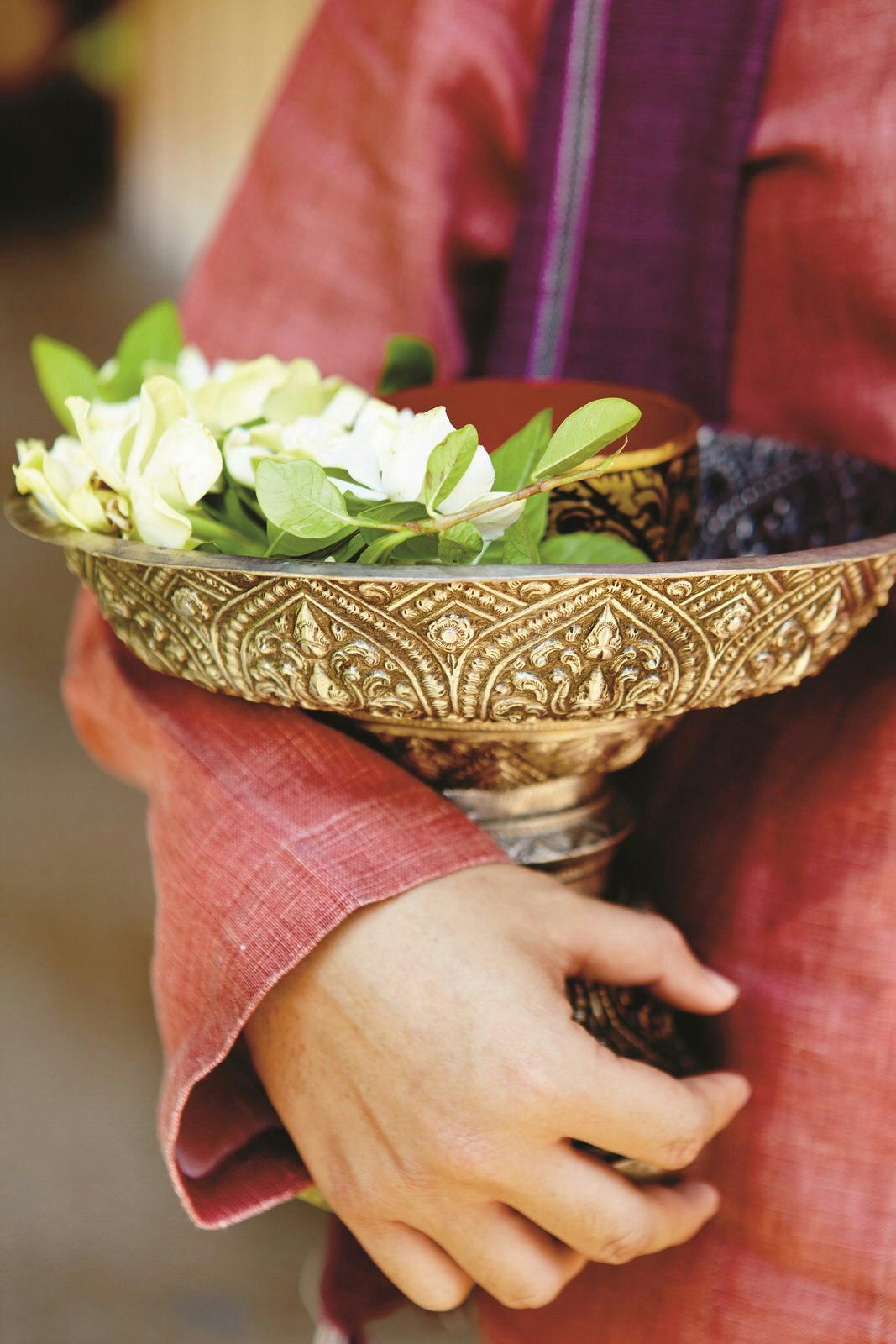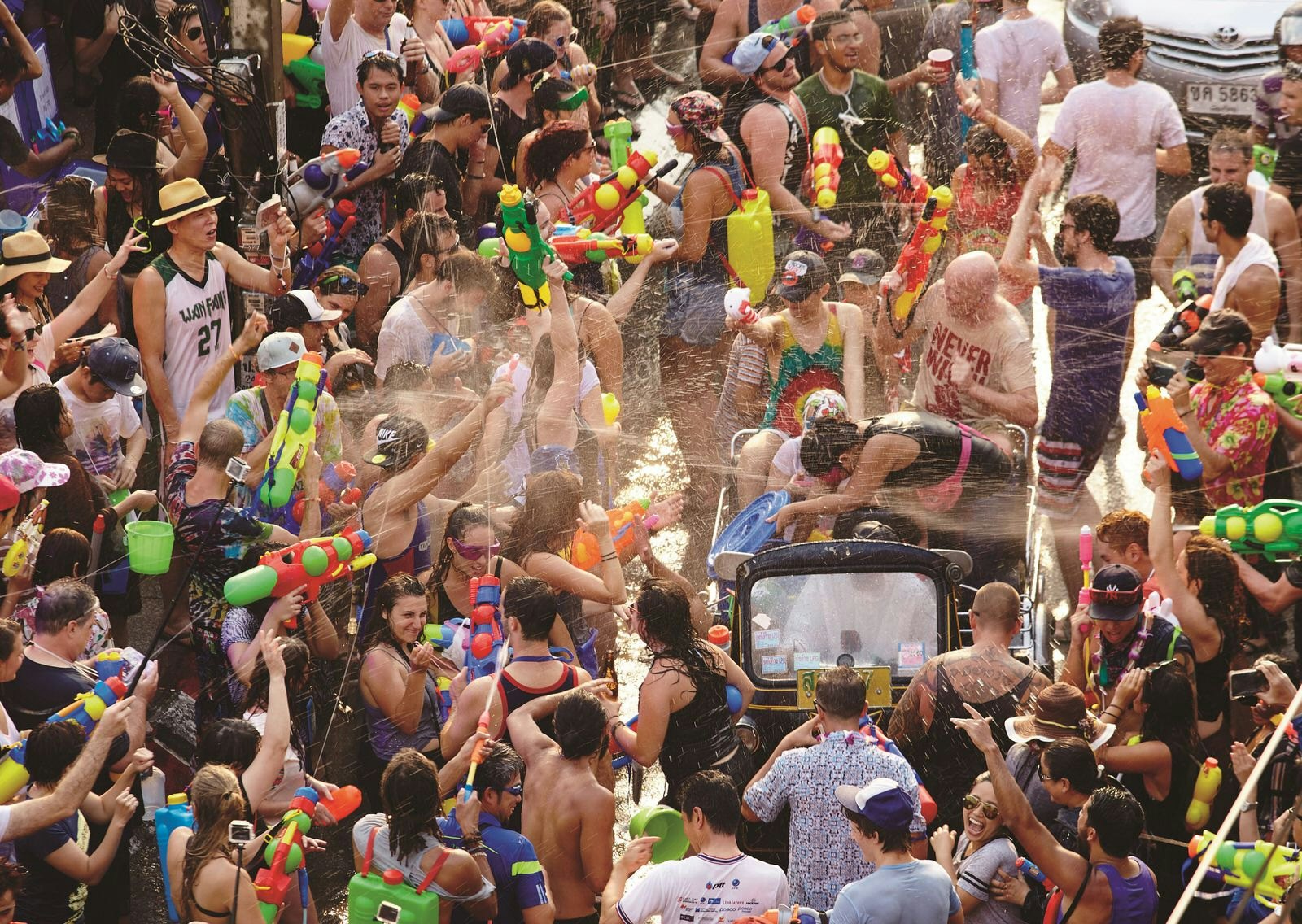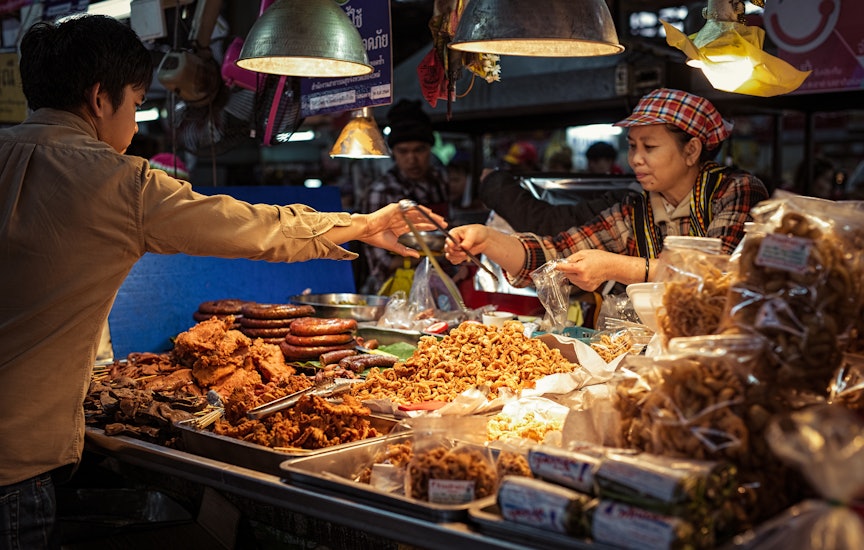

Songkran Festival parade dancers.
Buddhist New Year is the time to see Chiang Mai, Thailand’s second city, at its most animated, from the religious processions to the water-warring, wringing-wet antics of local residents.
This article appeared in the Spring 2018 issue of Lonely Planet magazine's U.S. edition.

For long months, summer has been building to a crescendo in northern Thailand, slowly filling the bowl of mountains that surrounds Chiang Mai with soupy heat.
By the middle of April, a sticky, wilting haze dulls the glint from the gilded Buddhas that gaze serenely out from the city’s 300-plus temples. The scents of frangipani, mango and hyper-spiced street food have been slow-cooked to a ripe miasma; the contents of the four-mile moat that girdles the Old City simmered to a green broth.
Something has to give and it can’t wait until the rains come in late May. At dusk on April 12, the sidewalks downtown begin to mass with excitable water warriors, fingers on plastic triggers, thumbs pressed over hose tips, buckets abrim. Ahead lies a four-day, man-made monsoon, which will saturate the city’s streets and all who sail in them.
By tradition officially stretching from April 13 to 16, Songkran is the spray-and-pray festival that marks the Buddhist New Year on April 15. It’s a bewildering but glorious fusion of dignified religious faith, familial devotion and deafening, Technicolor aquatic madness.
As a celebration of towering national importance, Songkran – the name comes from a Sanskrit word that means “transformation” or “change” – is like a Western Christmas and New Year rolled into one, with a soggy side order of trick-or-treat Halloween mayhem.

Every dawn, families file soberly into temples with offerings and votive decorations. Every afternoon, rather less soberly, they rush through the streets toting triple-chamber water pistols. The first activity endows good karma and the second good luck. Though it might not seem so at the time, a head-to-toe slapstick soaking is the best start a year could bring.
Around 95 percent of Thais are Buddhist, and Chiang Mai – for 500 years capital of the old Lanna kingdom, the nation’s rural heartland – prides itself as a repository of spiritual and communal tradition. Nowhere else is Songkran celebrated so wholeheartedly: here, the festivities are strung out for an extra day and with an enthusiasm that draws crowds from across the land.
Initiate conversation on the street – ideally during the buckets-down cease-fire that tentatively holds from 8pm to 10am – and you’ll often find yourself talking to one of the countless northerners who’ve relocated to Thailand’s more prosperous south, returning to their ancestral homeland for a uniquely profound New Year experience. It’s an opportunity to renew and reaffirm traditions, and the family bonds that Thais hold so dear. Even at Songkran, blood is much thicker than water.
“We just don’t have temples like this in Bangkok,” says Chiang Mai-born Kompun, admiring the weathered dragons that guard the 19th-century Wat Ton Kwen. “And the people up here are more kind and respectful. They always have time for you.”
With its somber, dark wooden gables and scattering of silent, orange-robed monks, the temple is a model of ascetic restraint. It’s just a few miles outside the city, but a world away from the power-shower delirium. Only the colorful and intricately cut paper flags that sprout from towers of sand acknowledge the festivities.

Kompun and her son Wasin have already added their contributions: the flags are themed to their respective zodiac signs, and an enshrined Songkran tradition is to bring a bucket or bag of sand to the temple, replacing the earth that worshippers have carried out on their feet over the previous year. Now, she sprinkles saffron-perfumed, jasmine-petaled water on the golden head of the temple’s Buddha.
“It’s a blessing, to wash away the old year and make a good start for the new one.” With a nervous smile, she admits she won’t be participating in the super-soaked anarchy that has burst forth from this graceful, symbolic act.
Clean-slate renewal and ritualized “merit making” are the twin spiritual cornerstones of this festival. The former manifests itself in the redecorating of temples, intensive spring cleaning and the wearing of garish new clothes: families congregate in matching Hawaiian shirts and drape floral garlands around each other’s necks. The latter, the earning of good karma for the coming year, begins in earnest on the penultimate dawn of the old one, on April 13, when a long line of monks files through the red-brick columns of Tha Phae Gate, one of the four entrances to Chiang Mai’s 13th-century Old City.

A dense crowd presses around them, toting offerings that are devoutly held forth with a respectful bow or on desperate occasion slam-dunked over a sea of heads into the monks’ silver bowls. These swiftly overflow with an extraordinary blend of the decorative and the practical: lotus-blossom bouquets, neat banana-leaf parcels packed with sticky rice, bags of crisps, drink cartons, torches, disinfectant, rolls of toilet paper. Thailand’s 38,000 temples are almost entirely reliant on donations from the faithful, and Songkran is their greatest alms-harvest.
“I see some monks who maybe like the free food too much,” Kruba Noi says, laughing. He is a slender novitiate who, at 19, has worn the orange robe for eight years. His temple lies out in the rice fields, an hour from Chiang Mai in the village of Baan Mae, and his Songkran is largely spent accepting alms from kneeling, shoeless farming families and chanting convoluted, quick-fire blessings in return. On request, he must pay tribute to ancestors, angels, household spirits and deceased pets. It’s tough vocal work: by the end of a long morning, he’s mumbling rapidly, like a drowsy livestock auctioneer.

At Songkran, it can feel as if every other Thai male is a monk and there has indeed been a surge in numbers in recent years: the country is currently home to more than 300,000 monks. Some elders sniff that most newbies are young men who sign up for just a few months, drawn by the chance to study, the free bed and board, and especially the kudos. A stint as a monk bestows much familial karma and is a very attractive entry on the résumé of a potential employee or husband. Kruba Noi, though, is in it for the long haul.
“For me, this festival is about renewal, the birth of a new year, and another opportunity to improve myself,” he says, referencing an allegiance to reincarnation that underpins his religious career. Asked why he chose to become a monk, he looks nonplussed: “It wasn’t a choice. I was a monk in a previous life and just responded to that call.”
In Baan Mae, extra-temple festivities are rooted in deference and fraternity. Families wander through the bamboo glades and knobbly fruited kaffir lime trees, and into each other’s open-sided teak houses, offering baskets of kanom tian, little pyramids of tapioca and coconut wrapped in banana leaves, to elderly relatives, teachers and respected shamans.
Rural Songkran is a largely dry affair, though Aoi Silphisuth, who runs a homestay cookery school in the village, points out the tin troughs that stand in wait by some thresholds.
“Just in case, you know, for defence,” she says with an air of mischief.
Her family will go into Chiang Mai for an evening squirt, though her son is well aware that their armory – a kid’s bucket and a plastic bottle with a hole in the lid – will see them mercilessly outgunned.

By early afternoon, it’s topped 100˚F back in the Old City, and a procession is wobbling out of the heat haze down a long, straight avenue. In Chiang Mai, April 13 is centered around this spectacle, one that began at first light with the hectic presentation of monkish alms.
Now, the sidewalks are dense with expectant worshippers and street vendors hawking festival fuel in all its forms: bags of khaep mu, the deep-fried pork rind that accessorizes every meal in the city; the challenging blend of bitter, black herb jelly and condensed milk called chao kuai; crate after crate of topless, hurl-ready bottles of cloyingly perfumed water. It always rains on this parade.
The dancers and musicians in the procession’s first ranks are a graceful riot of tortured woodwind, garish silk and delicate, synchronized movement. Lined up behind them, half-hidden by rolling arcs of spray, stretches an endless cavalcade of flower-smothered carnival floats, each bearing a Buddha on temporary leave from one of the city’s showpiece temples.
In the clamorous, sodden hours ahead, every statue and spectator will enjoy a comprehensive ceremonial cleanse. Yet as a Songkran water fight, this is no more than a dry run.

Come early evening, Chiang Mai is awash. A tide seeps over the threshold of every commercial establishment, and well-oiled, well-watered drinkers drench each other from the forecourt of every bar.
In the three days that follow, taking a tuk-tuk through the downtown crossfire feels like an unhinged theme park ride. You slide helplessly about on sodden vinyl, strafed by jets of chilled water, manic shrieks and waves of cheesy Thai techno. After a while, you realize the driver isn’t frantically hooting his horn to deter the hose-wielders and bucket-hurlers, but to get their attention. He’s laughing now, but might stop when he finds himself being paid with a lump of sodden pulp.
Double-wrapped waterproof pouches for phones and cash are a Songkran essential. So too, if you run the watery gauntlet along that microbially rich moat, are swimming goggles. Wet, wet, wet. You feel it in your fingers, you feel it in your toes. Thailand’s government, reacting to traditionalist concerns, has issued an edict for decorous restraint, though you’d never guess it.
A dry shirt is a target: unassuming, overdressed visitors are given a full-body tsunami the second they leave their hotels. The street is a logjam of pickups, each home to a rain barrel and a sodden, gleeful family.
One group totes giant syringes, piped into backpack reservoirs. High-velocity, pump-action super-soakers are the preferred youth choice, but the more experienced have come to learn that for instant, shock-and-awe impact, nothing beats a bucket.

The Songkran aqua-battle is by no means just a young man’s game: put a brimming pail in a grandfather’s hands and he’s seven again, tapping into that ageless, universal thrill of the spill. As an outsider, it’s difficult to subdue the hard-wired reflex to take the assailant to angry task. Even more so when it transpires that you’re expected to thank them for the blessed sluicing away of grubby old misfortunes.
Every visitor to Thailand will be told about sanuk, the national credo of taking pleasure from every life experience, both rough and smooth. The sight of very drunk people peaceably hurling water into each other’s faces for four days straight must rank as sanuk’s ultimate expression.
“For 360 days, Thai people are super-polite and respectful,” says a very wet Athirath Arunyaka, up from Bangkok to soak up Songkran with his Chiang Mai–resident family. “This is like a purge of all our bad behavior.”
It’s the final night of the fight, the storm before the calm. In the morning the silent streets are lined with a colorful detritus of cracked buckets, broken water pistols and soggy garlands, the air heavy with old beer and incense.
Tentatively, the sidewalks fill with the extremely old and the very young, kept inside for their own safety. Previously unviable cycle rickshaws return to the road, personal space is once more painstakingly respected. But the heat is already bullying and today there will be no baptismal relief.















